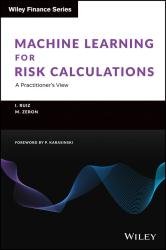Machine Learning for Risk Calculations: A Practitioner's View
- Добавил: literator
- Дата: 30-12-2021, 18:09
- Комментариев: 0
 Название: Machine Learning for Risk Calculations: A Practitioner's View
Название: Machine Learning for Risk Calculations: A Practitioner's ViewАвтор: Ignacio Ruiz, Mariano Zeron
Издательство: Wiley
Год: 2022
Страниц: 464
Язык: английский
Формат: epub
Размер: 24.0 MB
State-of-the-art algorithmic Deep Learning and tensoring techniques for financial institutions.
The computational demand of risk calculations in financial institutions has ballooned and shows no sign of stopping. It is no longer viable to simply add more computing power to deal with this increased demand. The solution? Algorithmic solutions based on Deep Learning and Chebyshev tensors represent a practical way to reduce costs while simultaneously increasing risk calculation capabilities. Machine Learning for Risk Calculations: A Practitioner's View provides an in-depth review of a number of algorithmic solutions and demonstrates how they can be used to overcome the massive computational burden of risk calculations in financial institutions.
This book will get you started by reviewing fundamental techniques, including deep learning and Chebyshev tensors. You'll then discover algorithmic tools that, in combination with the fundamentals, deliver actual solutions to the real problems financial institutions encounter on a regular basis. Numerical tests and examples demonstrate how these solutions can be applied to practical problems, including XVA and Counterparty Credit Risk, IMM capital, PFE, VaR, FRTB, Dynamic Initial Margin, pricing function calibration, volatility surface parametrisation, portfolio optimisation and others. Finally, you'll uncover the benefits these techniques provide, the practicalities of implementing them, and the software which can be used.
There are several open source libraries that offer Deep Learning functionality. The following are some of the most popular ones:
- TensorFlow. This is one of the most famous open source platforms for ML. Its main focus is on the training and inference of Deep Neural Nets. It was developed by the Google Brain team.
- Keras. This is an open source Python interface to the TensorFlow Library. Keras was the library used for the Deep Learning functionality in the solutions presented throughout this book.
- PyTorch. Although not used in the implementation of the solutions and tests in this book, we think it is important to mention it as it has become in recent years one of the most used libraries for Deep Learning. PyTorch is the Python interface to the Torch library, an open source ML library. It was developed by Facebook's AI Research lab.
The following are the two libraries used to implement the Chebyshev functionality component of the solutions used in the applications of Part IV in this book.
- MoCaX suite. This consists of two libraries developed by us. It offers all the Chebyshev functionality needed for the solutions described throughout this book. It was developed with a focus on the application of risk calculation. It is available in Python and C++ and can be freely downloaded.
-Chebfun. The Chebfun project was initiated by Professor Trefethen of Oxford University, who leads one of the most important research groups in approximation theory. Chebfun has been developed in MATLAB and offers a substantial range of functionality for CTs in dimensions 1, 2 and 3.
Other libraries were used in both the implementation and testing of the solutions presented throughout this book. Some of the important ones in Python were Numpy, Pandas, Scipy, matplotlib and Seaborn. The quantitative finance components needed for many of the tests run relied on the open source software for quantitative finance QuantLib. Others relied on the financial toolbox in MATLAB.
- Review the fundamentals of deep learning and Chebyshev tensors
- Discover pioneering algorithmic techniques that can create new opportunities in complex risk calculation
- Learn how to apply the solutions to a wide range of real-life risk calculations.
- Download sample code used in the book, so you can follow along and experiment with your own calculations
- Realize improved risk management whilst overcoming the burden of limited computational power
Quants, IT professionals, and financial risk managers will benefit from this practitioner-oriented approach to state-of-the-art risk calculation.
Скачать Machine Learning for Risk Calculations: A Practitioner's View
[related-news] [/related-news]
Внимание
Уважаемый посетитель, Вы зашли на сайт как незарегистрированный пользователь.
Мы рекомендуем Вам зарегистрироваться либо войти на сайт под своим именем.
Уважаемый посетитель, Вы зашли на сайт как незарегистрированный пользователь.
Мы рекомендуем Вам зарегистрироваться либо войти на сайт под своим именем.
